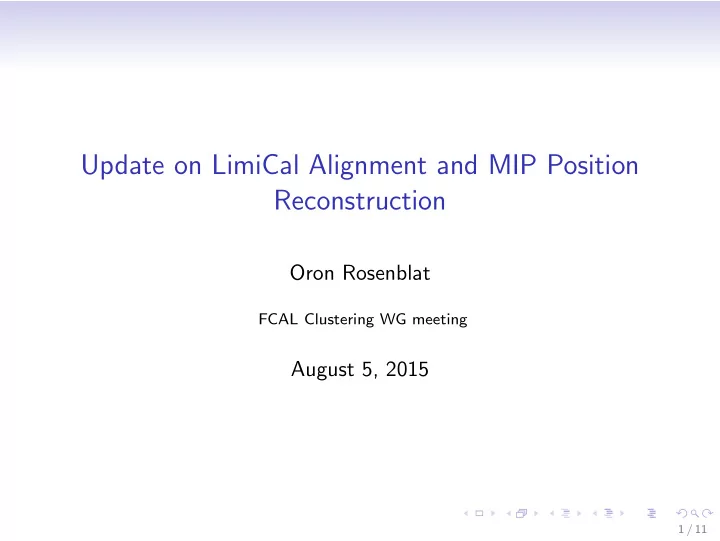

Update on LimiCal Alignment and MIP Position Reconstruction Oron Rosenblat FCAL Clustering WG meeting August 5, 2015 1 / 11
The stages of analysis which were carried out: 1. Subtraction of baseline 2. Removal of common mode noise 3. Deconvolution 4. Synchronization between LumiCal and telscope data and selection of single track events only 5. Selection of muon events 6. Extrapolation of track hit locations on first LumiCal plane 7. Propagation of hit locations to the next planes Note: This was done for each configuration seperately, since the boards may have shifted during the insertion of the tungstan plates. 2 / 11
Hitmap recieved after signal proccessing and synchronization (example - plane 0, configuration 1) 3 / 11
Added borders between pads: the structure is rigid i.e. was shifted and rotated as a whole. As a first approach, this was done visually. (a) plane 0 (b) plane 1 (c) plane 2 (d) plane 3 Data from configuration 1. A slight tilt around the z-axis is visible 4 / 11
According to this structure, the location of each hit can be defined (i.e. which pad was hit and where). E upper Next, for each event define the quantity η = E upper + E lower , indicating charge sharing between two adjacent pads. Using telescope hit locations, the dependence of η on the distance from the center of the lower pad can be investigated. 5 / 11
Distance 0 is middle of lower pad, 1800 is middle of upper pad. The crossing between the two pads is around 900. 6 / 11
The knowlege of this function can facilitate in determination of vertical MIP hit location: for a given event in LumiCal η can be measured, and from the above dependence vertical hit position can be extracted. The same procedure can be repeated for the horizontal axis, but due to the structure of LumiCal statistics and percision are expected to be much lower. 7 / 11
Next introduce a misalignment. In this example: 300 µ m vertical shift. The function is shifted by approx 300 µ m in the distance axis 8 / 11
This example: 3 deg. rotation around the center of the structure. Here one must look at difference between pads left and right of the vertical line (one appears as positive verical shift and one as negative) The difference between right and left is visible. In order to align one must demand that they coincide 9 / 11
Last example: 300 µ m vertical shift + 3 deg. rotation around the center of the structure Both effects can be seen (w.r.t the good alignment) 10 / 11
Conclusions: • MIP hit location could be calculated from charge sharing properties of LumiCal • It may be possible to align the LumiCal planes using the data recieved from the tests • The effect of vertical shifts and rotations on η (dist) function is clearly seen • Horizontal shifts must still be investigated • For now, all the plots are created using the telescope data. In order to perform in-situ alignment, the above profiles must be obtained from LumiCal data only. This can be done by integrating on cumulative η distributions • To be continued... 11 / 11
Recommend
More recommend